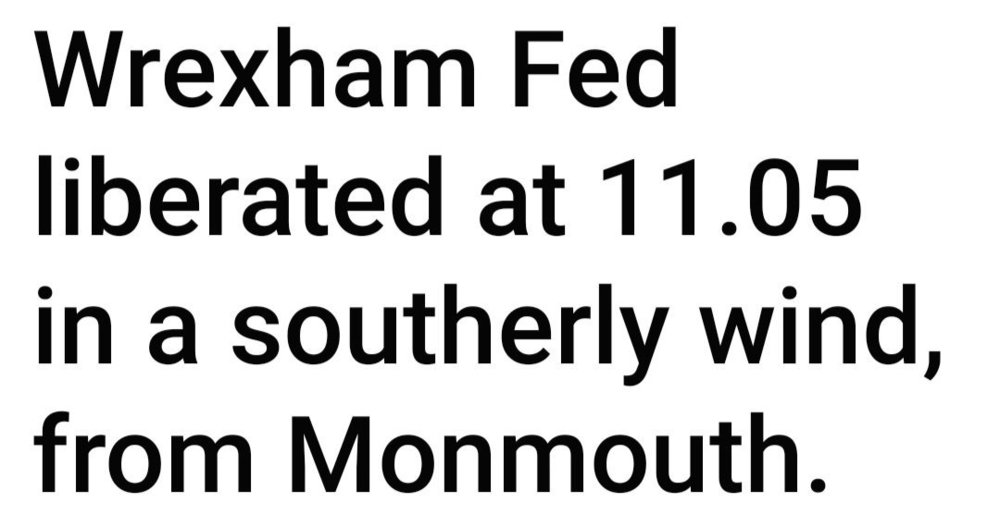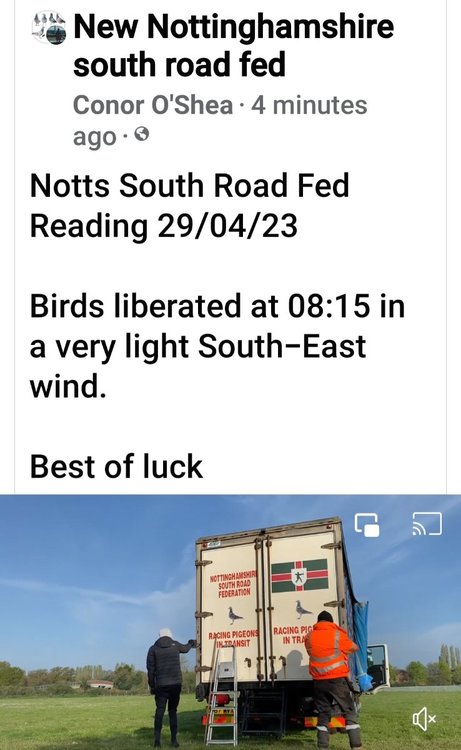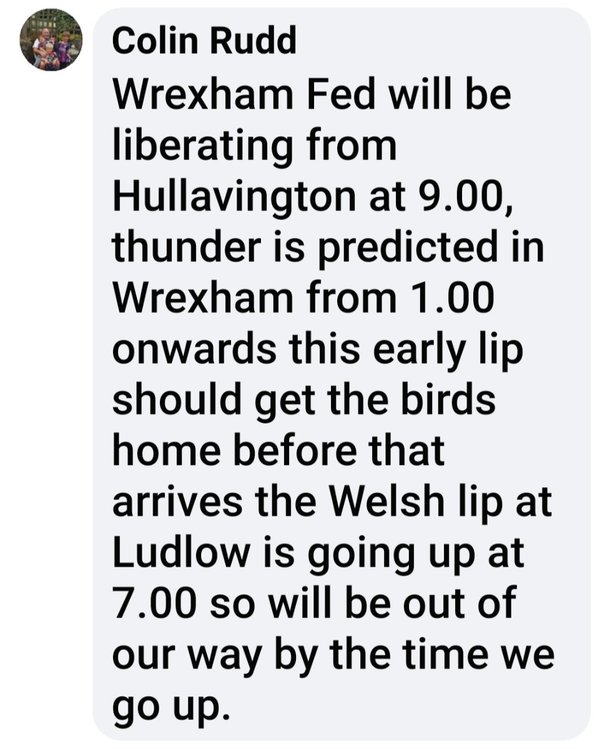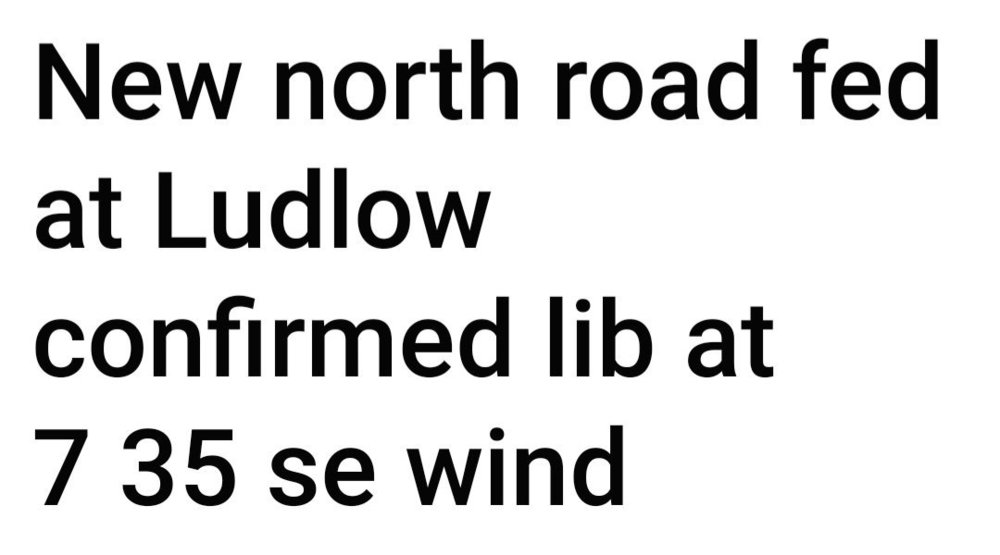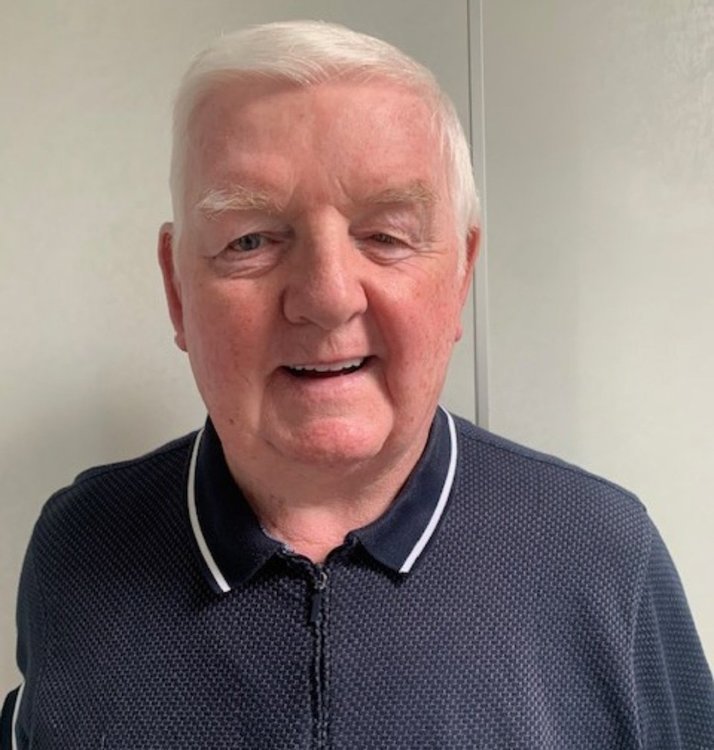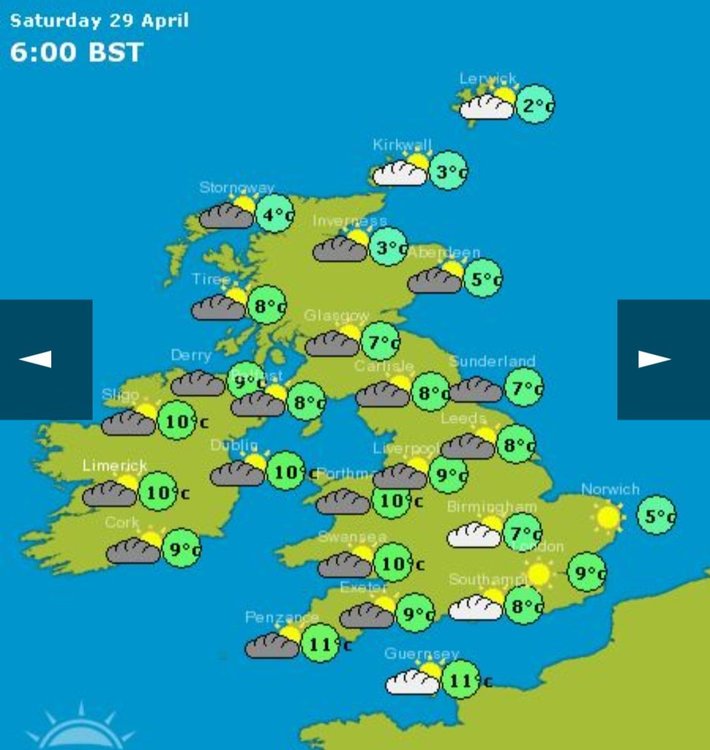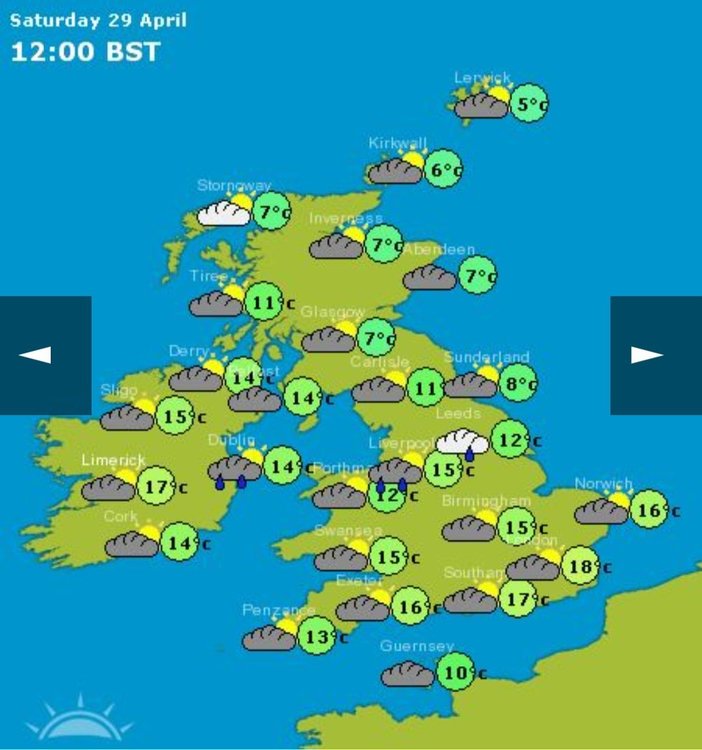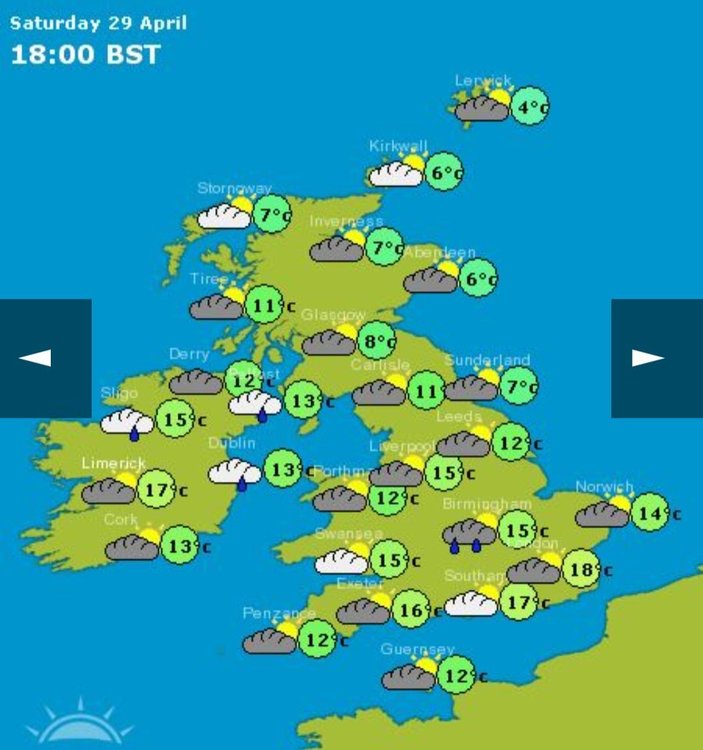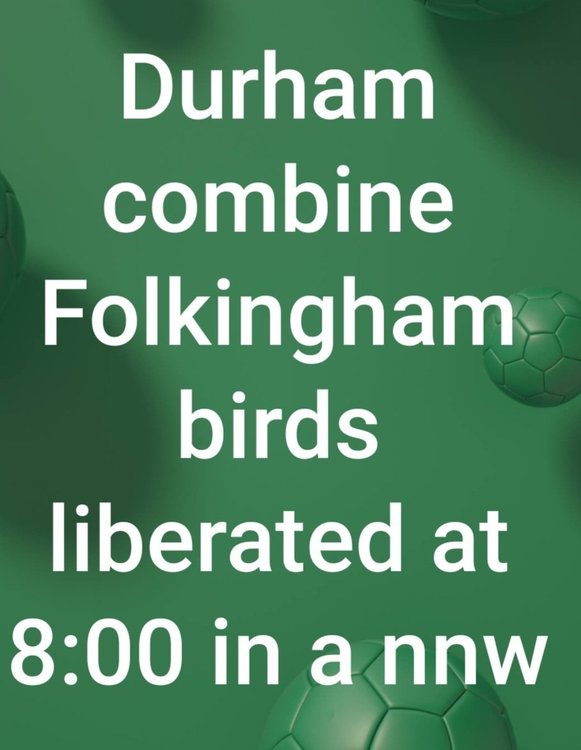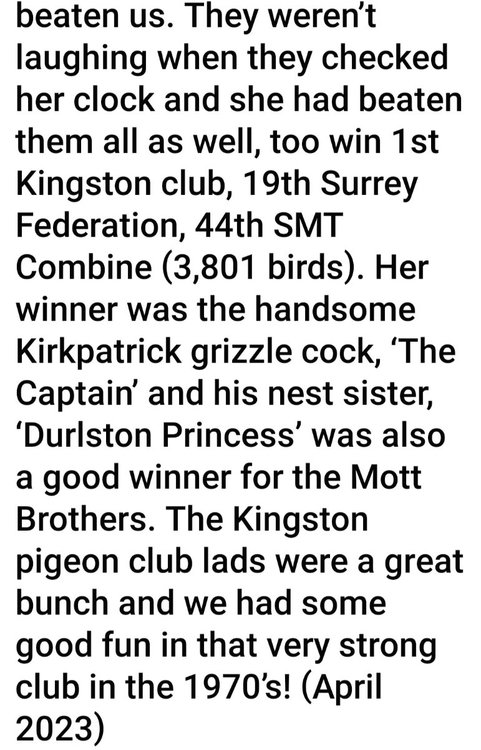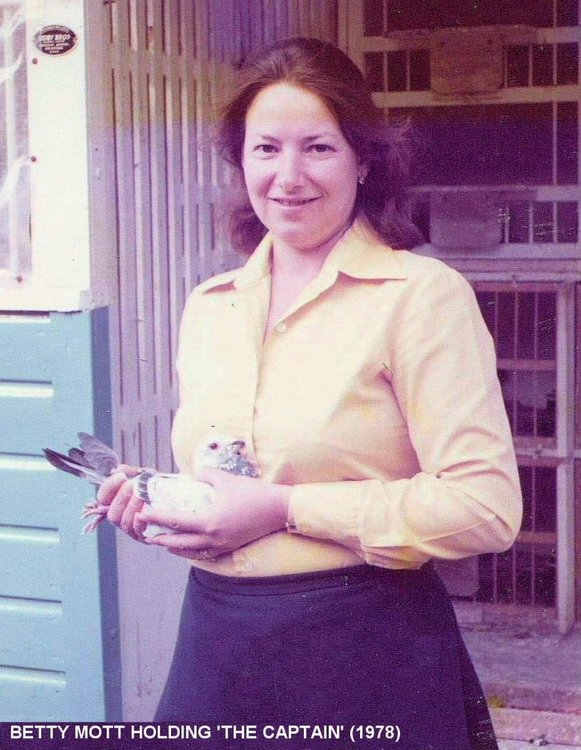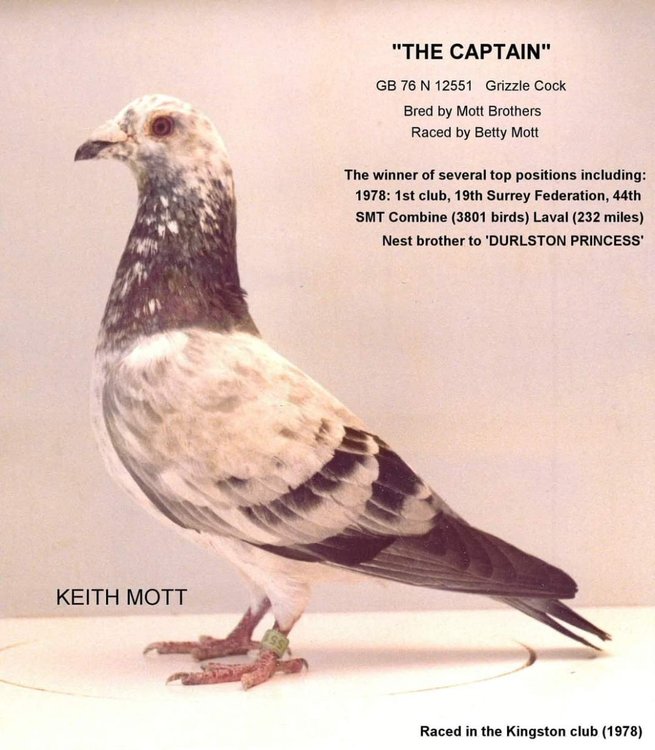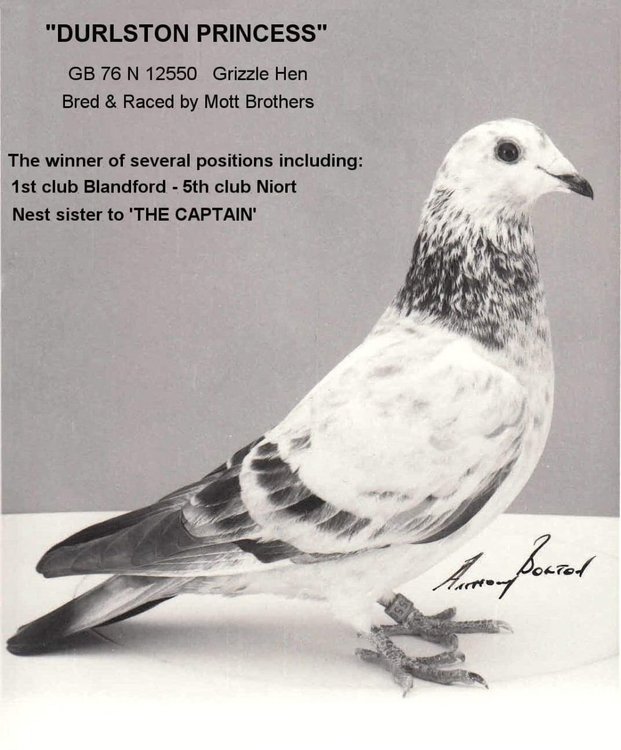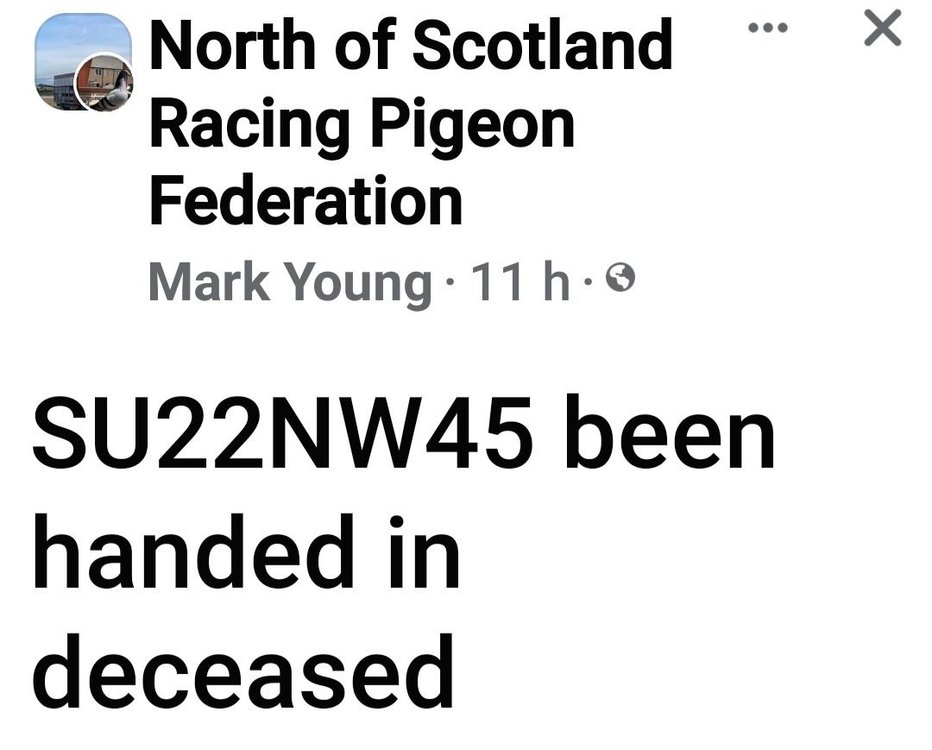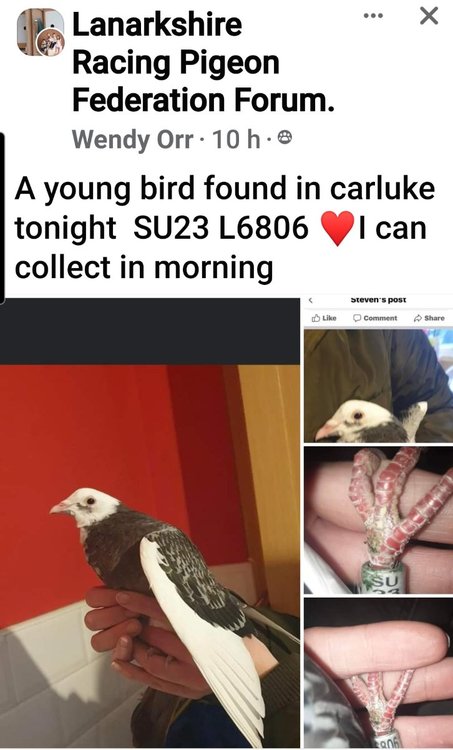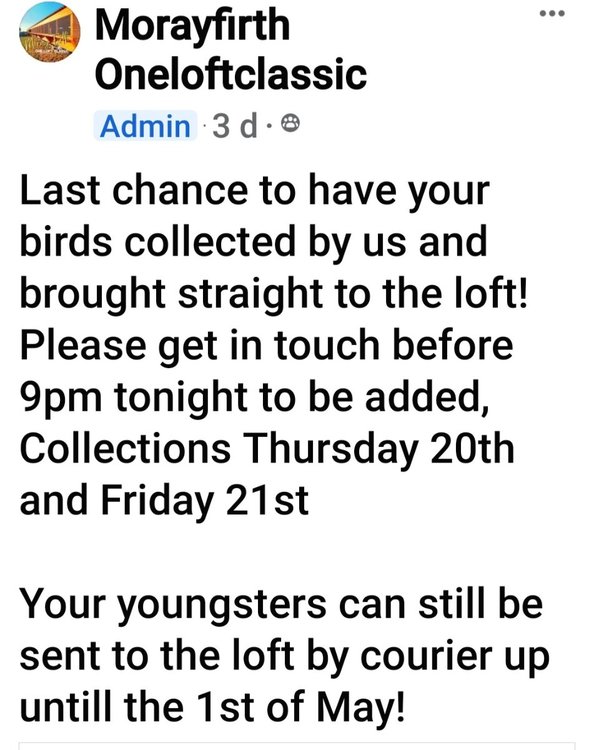The Joe Murphy Column
I received a lovely Thank You -So Very Much- card from Henry Mair of Irvine; who wrote; Your
Article on the ‘Blue Blitz’ (Shillinglaw & Whylie) SNFC Gold Cup winners, was really excellent. It
gave us ALL a ‘Real Insight’ to the SNFC in Scotland and beyond. It is one of the BEST ARTICLES
I HAVE EVER READ, in the BHW. Billy Wortley and the late Bobby Kennedy (Culzean) would be
proud of your article. Once again Joe, keep up the fantastic work you do for the Pigeon Sport up here
in Scotland. Wishing you and Margaret all the best Henry and Etta. While on about the old articles, I
came across one on Johnny Dora and his son Paul of Arbroath. Mr Dora’s father left Italy to settle in
Arbroath at the beginning of the 20th Century and survived the Elliot Rail Road disaster in 1906,
which killed 22 people. John Dora was born in the Angus town in 1905; the budding sports star
played for the now defunct Arbroath Ardella Junior Football Club as an inside forward. He made his
Parma debut in 1925 and played against Juventus and AC Milan in his first season in Italian
football. His career with Parma didn’t get off to the best start after he was mocked because of his
provincial origins by his own fans who were known for their ‘snobbery’. However, Johnny silenced
his critics – quite literally – during a friendly against an Austrian team. He dribbled through the other
side’s defence and rounded the goalkeeper before gently placing the ball on the goal-line –
then walked straight off the pitch. A hush fell over the stadium before the Parma fans erupted in
praise and a legend was born. After the match the Parma officials awarded him a Gold Watch and the
incident is still fondly remembered to this day by the Italian club. Mr Dora, who served in the Royal
Navy during the 2 nd World War, was described during his time in Italy as a footballer who had
managed ‘To implant into his Latin fantasy, the solidity and the attentiveness of the British style’. He
returned to Scotland despite interest from Bologna and Inter Milan and played for Arbroath – scoring
a hat-trick on his ‘Lichties’ [this is their nickname] debut against Falkirk. John Dora started keeping
pigeons on Armistice Day in 1918, and he was a consistent winner; pedigree was always been the
yardstick of the Dora success (which I agree). And this was written in 1966; Mr Dora ran a fish and
chip shop in his home town after his career ended in 1930 after breaking his leg, and he died at the
age of 65 in 1971. His star pigeons can be traced back to the original stock pair purchased from
Robert Stoddart. Since then, introductions from such notables as Jock Reid, (Stenhousemuir) and
Duncan Ogilvie (Stirling) helped produce birds such as grizzle cock, twice winner of 1 st club
Christchurch (404 miles) and 18 th open Nantes (648 miles), being the only bird timed north of the
Forth. Then there was the blue hen ‘425’ who won 15 th open Nantes and was then tragically killed on
wires while exercising round the loft. When son Paul joined the partnership, the Dora fortunes soared
to even greater hights culminating in what is every Scottish fancier cherished ambition, the winning
of the Scottish National Rennes race of 1961 with a convoy of 5273 birds competing. This result was
achieved by blue chequer cock ‘802’ now famous known the world over as ‘THE FIFER’. [See
photo] ‘The Fifer’ was a slow starter and didn’t show form until he won 1 st Preston and 2 nd Lancaster
as a 2-year-old. Then in 1960 he showed his doggedness by taking 145 th open SNFC Rennes with the
very low velocity of 514. In 1961 the year of his triumph, he previously won 1 st club Worchester,
then marched on to victory in the National. A fabulous achievement that is unlikely to be repeated.
‘The Fifer’ went on to fly Rennes twice more, both very hard races and he really earned his glorious
retirement where he turned out progeny that where a credit to his illustrious career and kept the name
of Johnny & Paul to the forefront of national racing for many years. Not content with that, Johnny
and Paul, also timed in their old war-horse ‘Rocky’ to win 1 st Tayside Federation Dol. [Great
memories of our past and if I can I will continue to add little snippets into my weekly column Joe
Murphy].
2
Race Results
This week begins the new season for 2023; let us hope that it is better than the previous ones we have
had since 2020. Once again, I’m prepared to add race results to my weekly column but I must
emphasise that I require these by Wednesday morning as I type up my article then and send it away
to the pigeon papers and web sites. If you have a photograph of your federation or club winner that
you wish to go with the report then just email this along with the report.
Pentlandhills Federation
News from Andy Miller who informs us that the convoy of 1537 birds entered by 65 lofts were
liberated at Otterburn on Saturday 15 th of April at 11-15am into a south east wind. Topping the
federation are S & S Tierney of Danderhall club with their winner doing a velocity of 1483, they
were also 16 th open. A Baillie of Danderhall club is 2 nd 4 th 15 th 17 th 19 th 20 th 21 st 23 rd 24 th & 26th Ronnie
Bremner of Sighthill club is 3 rd with club mate and federation president Andy Miller winning 5 th 6 th 8 th
11 th 12 th 13 th & 14 th positions. J Lamb of Edinburgh Premier wins 7 th place with W Pryde & son of
Arniston winning 9 th & 10 th open. Mr & Mrs Lindsay of Danderhall are 18 th 22 nd & 28 th with their first
bird an all pooler winning over |£300 for them. G Bennett & son also from Edinburgh premier are
25 th with A Baillie in 26 th place K Wright of Danderhall is 27 th with A Winter of the same club in 29 th
spot and Stevie Girdwood of Sighthill makes up the 30 th open places. The total pay-out in pools was
£947.70. The officials would like to thank the members who participated in the Breeder/Buyer:
particularly to Scott Girdwood for his sterling commitment to this venture. All ring numbers MUST
be submitted to Scott no later than the 1 st May 2023. Prize Money will be announced when all
outstanding money has been paid to Scott. My thanks to Andy for the photograph to go with his
report.
East of Scotland Federation
News from Tom McEwen who writes; The birds were transported with Pentlandhills Federation and
were liberated at Otterburn on Saturday 15 th of April at 11-15am into a south east wind. Topping the
federation and also taking 5 th open is Gus Jackson of Macmerry, starting where he left off last season
is Keith Howie of Prestonpans having a foursome; finishing in 2 nd 3 rd 4 th & 6 th places, making it a
great race for Keith. Davy Blair also from the ‘Pans’ is in with 2 good ones in 7 th & 9 th open places.
Tom and his son Scott McEwen of Elphinstone have a nice double finishing in 8 th & 10 th positions.
Prestonpans HS
Taking first 3 places in the club is Keith Howie with a yearling blur cock from his number one stock
pair; making it a full brother to his famous ‘Blue Arrow’ his great pigeon. His 2 nd pigeon is a 2-year-
old blue cock bred by Spider Rowley from his Van Den Bulk x Cooreman bloodlines. As a youngster
it won 1 st club 2 nd federation Otterburn and then as a yearling he topped the federation from Billericay
open. Keith’s 3 rd bird was a yearling blue cock the same way bred as Keith great pigeon ‘Blue Arrow’
making it a full brother to the club winner this week. Tom finishes off by saying; ‘That is started a
new season once again Joe, wishing you and Margaret all the best; cheers Tom’.
Fife Federation
Hi Joe, hope all is well. I was wondering if it was OK to send you the FED results this year again?
3
For inclusion in your column in the Homing World. There are some changes to the FED sections this
year. According to the rule book Kennoway club should have been flying in the Centre section for
years, and some individual members have now been put into their correct sections.
The East section winners are as follows; St Andrews club take the first 7 places these are R
Anderson; Dave Baldie; R Cochrane; I Downie; J Harcus; D Jack and A Suttie. Methilhaven club
members take the last 3 places in the east section, these are D Armour; G Baxter & G Caffrey.
The Centre section is won by Kennoway club members; J Benvie; B Chalmers; T Cook; S
Diamond; S Fyffe; S Fleming; Honeyman & son; K & N Honeyman; M Honeyman; B Kinnear.
West Section is won by R Cunningham of Tayport; With Crossgates members taking the following
positions; D Barnes; G Bell 1; G Bell 2; C Buchanan; K Cochrane; R Cook, P Cuthbert; P
Drummond A Fleming.
Space Weather Chart
The 27-day Space Weather Outlook Table; Issued on the 17 th April 2023 is as follows;
# UTC Radio Flux Planetary Largest
# Date 10.7 cm A Index Kp Index
2023 Apr 17 178 5 2
2023 Apr 18 170 5 2
2023 Apr 19 168 5 2
2023 Apr 20 168 5 2
2023 Apr 21 175 8 3
2023 Apr 22 172 12 4
2023 Apr 23 172 10 3
2023 Apr 24 172 5 2
2023 Apr 25 168 5 2
2023 Apr 26 162 15 5
2023 Apr 27 160 18 5
2023 Apr 28 160 15 5
2023 Apr 29 160 15 4
2023 Apr 30 165 15 5
2023 May 01 172 12 4
2023 May 02 172 10 3
2023 May 03 172 8 3
2023 May 04 170 8 3
2023 May 05 172 5 2
2023 May 06 172 5 2
2023 May 07 172 12 4
2023 May 08 178 5 2
2023 May 09 182 5 2
2023 May 10 182 5 2
2023 May 11 182 8 3
2023 May 12 182 8 3
2023 May 13 175 5 2
Once again you will see the reading for this weekend 29 th -30 th April is very high, so take care.
Joe’s Joke
The seven dwarfs always left early each morning to go to work in the mine. As always, Snow White
stayed home doing her domestic chores. As lunchtime approached, she would prepare their lunches
and take them to the mine. One day as she arrived at the mine with the lunches, she saw that there
had been a terrible cave-in. tearfully, and fearing the worst, Snow White began calling out, hoping
4
against hope that the dwarfs had somehow survived. 'Hello. Hello!' she shouted. 'Can anyone hear
me? Hello!' For a long while, there was no answer. Losing hope, Snow White again shouted, 'Hello!
Is anyone down there?' Just as she was about to give up all hope, she heard a faint voice from deep
within the mine says, ‘VOTE SNP!’
Snow White fell to her knees and prayed, Oh, thank you, God! At least Dopey is still alive!
Please continue to keep the news flowing; to Joe Murphy Mystical Rose Cottage 2 Flutorum
Avenue Thornton by Kirkcaldy KY1 4BD or phone 01592 770331 or Email to
joejmurphy1@gmail.com REMEMBER THE J IN THE MIDDLE or log onto
www.elimarpigeons.com www.fancierchat.co.uk www.pigeon-chat.co.uk who wish my weekly
contribution portfolio on pigeon topics from Scotland
Preview attachment Johnny Dora see text.jpg
Johnny Dora see text.jpg
46 KB
Preview attachment S & S Tierney Otterburn Fed Winner see text.jpg
S & S Tierney Otterburn Fed Winner see text.jpg
17 KB
Preview attachment The Fifer see text.jpg
The Fifer see text.jpg
36 KB






